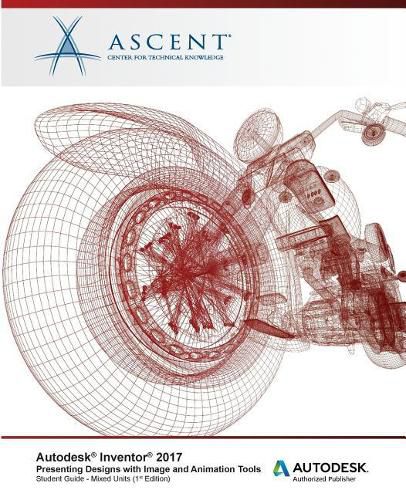Readings Newsletter
Become a Readings Member to make your shopping experience even easier.
Sign in or sign up for free!
You’re not far away from qualifying for FREE standard shipping within Australia
You’ve qualified for FREE standard shipping within Australia
The cart is loading…






The Autodesk® Inventor® 2017: Presenting Designs with Image and Animation Tools student guide teaches you how to present your Autodesk® Inventor® designs using tools that are available with the software.
You begin in the modeling environment, learning how to customize visual styles, include reflections and shadows in a display, set up and control lighting, and create and assign unique material appearances with the aim of enhancing how the model is presented. The student guide also discusses the Presentation and Inventor Studio environments, which can be used to create compelling still images or animations of a design.
The Presentation environment enables you to create snapshot views (still images) and animations to help document an assembly. A presentation file can be used to indicate how parts relate to each other and create an exploded view for a drawing. Animating the exploded view enables you to further show how components fit together in an assembly. Inventor Studio is an alternate tool that can also be used to create realistic renderings or animations of models that can be used in model presentations.
The topics covered in this student guide are also covered in the following ASCENT student guides, which include a broader range of advanced topics:
Autodesk® Inventor® 2017: Advanced Assembly Modeling Autodesk® Inventor® 2017: Advanced Part Modeling Autodesk® Inventor® 2017: Introduction to Solid ModelingTopics Covered
Enhance the appearance of surfaces and edges of a model by assigning visual styles, ray tracing, reflections, shadows, and a ground plane. Customize and assign lighting styles to control the number, color, and intensity of light sources in a model.
Manipulate the visual appearance of a material using the in-canvas appearance and texture tools. Create, assign, and edit existing appearances in the model using the Appearance Browser.
Understand how presentation files can be used to document an assembly model. Create a presentation file with animations or Snapshot views. Publish a presentation file to create images and videos.
Render a realistic image of a model that has had appearance, lighting, and camera customizations. Create a realistic animation of a model by applying parameters, constraints, and actions. Create a composite video by combining camera shots, animations, and transitions using the Video Producer. Create a custom environment for use when rendering models.
Prerequisites The material covered in this student guide assumes a mastery of Autodesk® Inventor® basics as taught in the Autodesk® Inventor®: Introduction to Solid Modeling student guide.
Enhancements that were introduced in the Presentation environment in the R2 release have been included in this version of the student guide. It is recommended that you use the R2 or R3 release of Autodesk Inventor 2017 with this student guide.
$9.00 standard shipping within Australia
FREE standard shipping within Australia for orders over $100.00
Express & International shipping calculated at checkout
The Autodesk® Inventor® 2017: Presenting Designs with Image and Animation Tools student guide teaches you how to present your Autodesk® Inventor® designs using tools that are available with the software.
You begin in the modeling environment, learning how to customize visual styles, include reflections and shadows in a display, set up and control lighting, and create and assign unique material appearances with the aim of enhancing how the model is presented. The student guide also discusses the Presentation and Inventor Studio environments, which can be used to create compelling still images or animations of a design.
The Presentation environment enables you to create snapshot views (still images) and animations to help document an assembly. A presentation file can be used to indicate how parts relate to each other and create an exploded view for a drawing. Animating the exploded view enables you to further show how components fit together in an assembly. Inventor Studio is an alternate tool that can also be used to create realistic renderings or animations of models that can be used in model presentations.
The topics covered in this student guide are also covered in the following ASCENT student guides, which include a broader range of advanced topics:
Autodesk® Inventor® 2017: Advanced Assembly Modeling Autodesk® Inventor® 2017: Advanced Part Modeling Autodesk® Inventor® 2017: Introduction to Solid ModelingTopics Covered
Enhance the appearance of surfaces and edges of a model by assigning visual styles, ray tracing, reflections, shadows, and a ground plane. Customize and assign lighting styles to control the number, color, and intensity of light sources in a model.
Manipulate the visual appearance of a material using the in-canvas appearance and texture tools. Create, assign, and edit existing appearances in the model using the Appearance Browser.
Understand how presentation files can be used to document an assembly model. Create a presentation file with animations or Snapshot views. Publish a presentation file to create images and videos.
Render a realistic image of a model that has had appearance, lighting, and camera customizations. Create a realistic animation of a model by applying parameters, constraints, and actions. Create a composite video by combining camera shots, animations, and transitions using the Video Producer. Create a custom environment for use when rendering models.
Prerequisites The material covered in this student guide assumes a mastery of Autodesk® Inventor® basics as taught in the Autodesk® Inventor®: Introduction to Solid Modeling student guide.
Enhancements that were introduced in the Presentation environment in the R2 release have been included in this version of the student guide. It is recommended that you use the R2 or R3 release of Autodesk Inventor 2017 with this student guide.